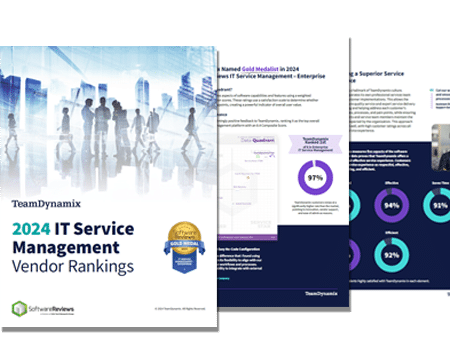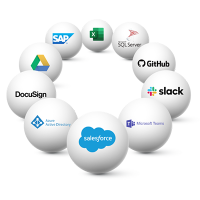
Understanding Change Management and Its Importance Within Your Organization
Did you know that a significant number of IT incidents occur when someone makes a change to one system that then affects other systems in

The Info-Tech ranking report offers a unique view of the market based entirely on in-depth customer interviews. Download the Info-Tech ITSM Quadrant and Customer Viewpoint report today.

We’ll show you some of our best situations and show you exactly how to execute them to get immediate results. The best part is, iPaaS tools often feature easy-to-use click and drag functionality, meaning you don’t need a dedicated employee building integrations and workflows.

System Integrators, Value Added Resellers, Technology Providers, and Buying Consortiums can benefit from a partnership with TeamDynamix.

The Info-Tech ranking report offers a unique view of the market based entirely on in-depth customer interviews. Download the Info-Tech ITSM Quadrant and Customer Viewpoint report to gain a better understanding of key vendor strengths and emerging market requirements.
Did you know organizations that practice formal project management are more likely to find success?
By having formal project intake and management processes in place, there is increased communication and transparency around each project being worked on in your organization. And with all that visibility, projects are more likely to stay on track and within budget.
There are a number of reasons why organizations find it to be crucial to engage in a formal project management process, with three of the most common being that it helps to fulfill:
It’s essential to utilize different project approaches and support tools for different parts of an organization and have these elements all work together cohesively.
But how can that be achieved, and how it can help an organization mature its overall project management capabilities while addressing resource risk?
To start, let’s first define what we mean by resource risk. In this context, resource risk refers to the potential challenges and uncertainties associated with the allocation, availability, and utilization of resources – such as time, budget, personnel, and equipment – while managing a project. These risks can impact the project’s timeline, cost, and overall success.
To mitigate resource risk, consider these best practices:
Utilizing Project Portfolio Management (PPM) can be a great way to mitigate resource risk. PPM can play a crucial role in addressing resource risk by:
But without solid project intake processes in place, and buy-in from the organization to follow proper project management practices, PPM can fall flat. The following are some project management best practices to follow to help ensure PPM success.
Too often, when any organizational activities are officially labeled “projects” they are automatically expected to be managed using one set of common “official” project management methods, processes, tools, reporting, etc.
In some cases, the internal project management office is even deployed to ensure compliance with the organization’s single project management standard. However, this approved project management standard is often way too much for many small project efforts happening at any given time throughout your organization.
What do we mean by this? Well, you wouldn’t find the same resource risk in building a house compared to building a high-rise building, would you?
As such, it’s difficult to get comprehensive resource risk information until you get the buy-in to label all appropriate organizational activities “projects.”
Most organizations can better categorize their projects and then size the appropriate project management standards for each class of project, to help identify small projects vs major projects.
When it comes to organization-wide project management, too often projects are included (or not) in project portfolios based on budget size and category alone, while omitting a resource risk.
Small, non-capital, non-strategic projects are often overlooked when it comes to the project portfolio, even if they use some of the same key resources that major projects do.
Regardless of size and scope, they should still be included in the portfolio, in some form.
It is important to recognize that this does not suggest the use of the same project management methods for both small and major projects. Rather, an important resource risk forecasted and used in small projects should be accounted for in the project portfolio if they are shared.
By putting all project efforts, large and small, in the project portfolio in some form, project managers can better see, and manage, all resource risks across the organization’s important project resources. This will result in better transparency and more resource efficiency.
A classic dilemma for project managers and their dedicated project resource risk is that these project resources are also frequently on-call for reassignment to other organizational activities that are not actually projects – but occur very regularly.
Dedicated project resources can be diverted for a variety of reasons that are deemed more important, like unplanned resource risk, organizational fires that pop up out of nowhere, maintenance projects, critical tasks, etc.
This might include something like a customer or system support crisis or maintenance updates or budget changes, for example.
A good way to help manage project resources that are actually on-call is to add some fixed annual operating category names to project portfolios. This can be as simple as estimating and posting actual resources against some fixed annual operating buckets like System Support Maintenance, for example.
At the end of each fiscal year, these various support task groups in the portfolio can then be reviewed to help analyze how they’re forecasted versus actual manpower use, cost, trends, impact on other projects, etc.
Again, if on-call activities impact important project resources, it is helpful to try to forecast and track a project resource risk in your project portfolio and keep your project managers updated.
In any environment, structure conveys a sense of stability and permanence.
For projects, a formal project management approach leads to greater adoption rates among individuals and business areas. And when the defined approach has been invested in by leadership, there is a broader and more rapid acceptance that project management is a discipline supported by the organization.
A formal approach to project management also allows individuals throughout your organization to recognize their roles and understand their accountabilities with the work that’s happening. This leads to a better comprehension of the value they add and the contributions they make to a given project, further supporting adoption.
However, while a common set of project management fundamentals is important, there is also a need to support significant differences.
Specifically, intake and prioritization are two areas that shouldn’t follow a one-size-fits-all approach and these areas are key to pinpointing your resource risk.
Size is not the only difference organizations must anticipate when developing a formal project approach or assessing resource risk. They must also recognize that different organizational areas will be at different levels of project management maturity and will, therefore, need to have different degrees of structure. If you over-engineer project management for a group, they are less likely to follow the processes you put in place.
In some cases, a simpler set of processes to support greater adoption and accessibility is needed.
In other areas, there may be a need for more rigorous processes to reduce flexibility and help ensure compliance with specific resource risks. This is especially for projects that have a high degree of external monitoring, impact regulatory requirements, etc.
There is also a balancing act between the best approach for the organization, while still encouraging adoption and compliance. The best approach in the world will fail if no one believes in it or supports it.
On the other hand, if the organization can balance the need for a robust project delivery approach with the need to develop sustainable adoption of that approach throughout the business, the long-term benefits will be significant.
Choosing the right approach that minimizes risk and cost is an act of balancing methodology, formality, structure and governance.
To learn more about Project Portfolio Management, click here.
This post was originally published in March 2020 and has been updated with new information.

Did you know that a significant number of IT incidents occur when someone makes a change to one system that then affects other systems in

The construction industry can be very volatile, with a high employee turnover rate due to seasonal fluctuations in the workforce. A key challenge for the

A study from Information Week and TeamDynamix shows companies are looking to invest in IT Service Management (ITSM) software that is simple to administer and
TeamDynamix’s award-winning SaaS cloud solution offers IT Service and Project Management together on one platform with enterprise integration and automation.
[email protected]
(877) 752-6196
Contact Us
